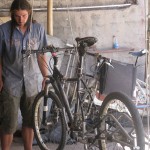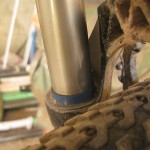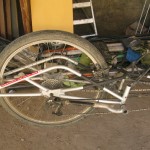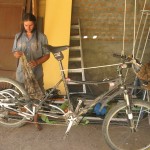Throughout the andes, women make a homebrew beer known as Chicha. Generally, in the highlands they use corn and sprout the kernels before cooking it, and in the jungles they use various root crops and chew it first to help with fermentation. Here are a few photos of some chicheras (brewers) making a huge batch of chicha for a wedding in a small andean village in the Sacred Valley.
[slidepress gallery=’chicha’]Category Archives: Peru
Check out one of the cool features with the SPOT Messenger, you can add photos to your mapped waypoints, describe your trip, and make a pretty cool interactive map/slideshow. Looks better in full size, so click on the headline below.
Cotahuasi River Trip
Widget powered by Spot Adventures: GPS Geotagging
Had to share this moment with ya´ll. Cycling to the horizon of the altiplano and encounter this guy riding a bike with only one pedal, no toe clips, and a bit of gear.
Over the years we have definitely seen our share of strange foods. Peru seems to top the list so far.
While it has certainly been strange to see Cuy (Guinea Pigs) being eaten as a delicacy here in the Andes, for some reason, a Cuy Pizza strikes me as the most bizarre food I´ve come across.
A few others:
 Mexico: Chapulines (grasshoppers) and mealworms: Walking through a market in a tiny village in the state of Oaxaca, the locals dared the gringo to eat some grasshoppers. Fried in spices they weren´t so bad. Mealworms were also added to the dare, a delicacy to be eaten while the creature is alive (though also sold dried and spiced)
Mexico: Chapulines (grasshoppers) and mealworms: Walking through a market in a tiny village in the state of Oaxaca, the locals dared the gringo to eat some grasshoppers. Fried in spices they weren´t so bad. Mealworms were also added to the dare, a delicacy to be eaten while the creature is alive (though also sold dried and spiced) Ecuador: Levanta de los Muertos (Raise the Dead): Another blended treat found in the mercado, said to be a cure for a hangover. Starts with alfalfa juice, then some beer or Pony Malta, some sugar, a puree of a fruit called borojo and for the delicious finale: 2 quail eggs shell and all, and a raw chicken egg.
Ecuador: Levanta de los Muertos (Raise the Dead): Another blended treat found in the mercado, said to be a cure for a hangover. Starts with alfalfa juice, then some beer or Pony Malta, some sugar, a puree of a fruit called borojo and for the delicious finale: 2 quail eggs shell and all, and a raw chicken egg.
 Ecuador & Peru: Suri: a large, plump grub that is food eaten in the jungle regions along the Amazon Basin. Prefer the mealworm to the suri. Check out the recent issue of WEND for a great story written about a culinary adventure in Iquitos, Peru. Even serve sloth at the markets there.
Ecuador & Peru: Suri: a large, plump grub that is food eaten in the jungle regions along the Amazon Basin. Prefer the mealworm to the suri. Check out the recent issue of WEND for a great story written about a culinary adventure in Iquitos, Peru. Even serve sloth at the markets there.
 Peru: Jugo de Rana (Frog Juice): In the market of Arequipa you can get this delicious drink. You first choose a frog, the woman proceeds to smash it dead against the table, skin and disembowel before briefly tossing it in boiling water, then into the blender with maca root powder, some beer, juice, spices. Believed to be a powerful aphrodisiac!
Peru: Jugo de Rana (Frog Juice): In the market of Arequipa you can get this delicious drink. You first choose a frog, the woman proceeds to smash it dead against the table, skin and disembowel before briefly tossing it in boiling water, then into the blender with maca root powder, some beer, juice, spices. Believed to be a powerful aphrodisiac! Ecuador & Peru: Cuy (Guinea Pig): Not just a pet. It tastes like chicken they say, yet, the flavor resembled fish more than chicken when I tried it. Skinned and served whole, not much meat on the creature, gotta kind of nibble around its cheeks and fingers. And yes, in Cusco, they will put this animal on a pizza for you as well.
Ecuador & Peru: Cuy (Guinea Pig): Not just a pet. It tastes like chicken they say, yet, the flavor resembled fish more than chicken when I tried it. Skinned and served whole, not much meat on the creature, gotta kind of nibble around its cheeks and fingers. And yes, in Cusco, they will put this animal on a pizza for you as well.
Rumor has it that some other delicious treats we have to look forward to: Horse jerky, duck ceviche, deer pate, and beaver. Will keep you posted.
Getting back on my bike was more difficult than I expected. The month long hiatus had taken its toll, and I had acclimatized to sea level.
We reorganized in Ayacocha, a small colonial town where the Shining Path, a Maoist guerilla organization got its start in 1980 with a philosophy professor at the university.
Out of town, we quickly escaped the traffic and noise and found ourselves cruising up and down the contours of small tributary valleys. Giant agave plants curled over the road periodically giving it a tunnel like effect, and the Nopales cactus crammed in with scrub brush and thorny trees. The landscape seemed to open up, a noticeable change from the wall of jungle in Central America and the steep climbs throughout the Andes. Still, it was not flat, we were climbing and dropping 100 meters a pop, but it doesn´t take long in the Andes to get the feeling that every mountain requires a 3,000 meter climb to cross over.
As we passed by small village huts, children with dirt and snot smeared across their face would yell, “Gringo Gringo.� with great delight. A phrase we hear hundreds of times a day, sometimes laced with venom, but for the most part, good natured. Goat was riding by and heard the mom tell them, “Hey that´s not nice, say hello.� And then the kids started chanting, “Hola Gringo, Hola Gringo.� Further up the road a farmer waved him over excitedly, holding a bag of coca leaves with a green oozy smile so full of leaves he couldn´t manage to say anything comprehensible. He wanted Goat to be as happy as he was and encouraged him to take a chew.

By the end of the day, I was beat and ready to camp. Goat had found a spot tucked behind some fields where nobody except for a few wandering dogs would come upon us. We set up camp before dark and enjoyed the clear skies and beautiful weather, refreshing, like California in early spring. A thick layer of clouds were creeping over an adjacent mountain range, displaying red and orange hues as the sun set.

We steadily climbed up a smooth valley, hey fields and crop covers all covered the hillsides in a golden hue. A large gathering was happening at a tiny one chapel church and I stopped to take some photos and enjoy the revelry. A huge 20 something piece band from Ayacucho was drinking outside the church, and everybody in the town seemed to have a drink in hand or were already too drunk to keep hold of one.
Here´s a few photos of my bike with the new HD Xtracycle.
Also check out the photo of the uppers on my Fox Vanilla Fork. Recently, we´ve blown two sets of uppers because of this. With 3,000 meter descents, you can toast a fork in a matter of hours if you aren´t constantly cleaning off the mud and dust.
We´re packed up and heading out mañana. On our way to Cusco and the sacred valley. Should be beautiful. Will post pictures soon.
Exactly three years have passed since we started our trip up in Alaska. Sometimes, while relaxing in camp we try to think about where we were on that day exactly a year ago, two years ago. Last Christmas at a rafting commune in Guatemala, New Years in a Garifuna Village along the coast of Honduras during a tropical storm, year before that in Moab, Utah enjoying the slickrock canyon country. This year we spent New Years on top of Cotopaxi Volcano at about 19,347 feet. Somehow, every day seems to bring us new adventures and challenges.
This cake was baked by JJ and Goat´s sister on our MSR Dragonfly Stove
We travelled from Prudhoe Bay, AK all the way through Canada and into the states in 3-4 months, but spent 6 in Mexico alone and maintained a similar pace through Central America. Our route through Canada and US was pretty straightforward, there were maps that easily communicated where the best routes would be. In Mexico, they became dangerously inaccurate; our hopes would rest on a desert oasis and we´d find ourselves splashing around in a mud puddle to cool off, trying to filter water through t-shirts before the water filter could possibly work. We became more accustomed to dealing with the unexpected aspects of travel and slowly but surely, bike touring ceased to be our adventure or vacation as much as it became our lifestyle.
Within this lifestyle, we came to accept that good beer no longer exists, there is only one type of cheese: queso fresco, and that sadly, tortillas become extinct in South America. Yet, culinary sacrifices are easy in light of being separated from friends and family for so long; we become uncles, relatives pass away, and our friends have adventures of their own. Sometimes it`s difficult to appreciate the experiences we find ourselves in – each waterfall starts to look the same, each conversation with the locals repeats itself, and the vistas from the high mountain passes feel uninspired. Yet curiosity keeps us pedalling south, and though we can´t always appreciate our experiences in the moment, time has a way of slowing down every once in a while, offering a glimpse of perspective into how extraordinary an adventure it has been.
We were recently sitting in a café in Huaraz with two other cycle tourists we met, one of the guys commented on why more of their friends haven´t joined them and why we don´t see more tourists en route, “What else could they possibly be doing? How could somebody not want to be a bike tourist. It is just such a sweet lifestyle.”
And I couldn´t agree more as I sat under a backdrop of the Cordilleras Blancas, some of the most impressive mountains in the world thinking about our recent experiences. A week before we were hanging out with bullfighters in a small country town, treated like rock stars, a day before that we were held at gunpoint by cocaine smugglers, and at the summit of the white mountains we were greeted be a fierce snowstorm. “Only while Riding the Spine” I thought to myself.
Now that we´re approaching the border of Bolivia, we are for the first time imagining that we will actually arrive in Tierra del Fuego. We have escaped the tropical latitudes near the equator and are starting to reach familiar climates; we are seeing less tropical fruits, and for the first time in ages seeing peaches and apples. We no longer encounter daily and nightly rain storms, but will be passing through some fo the driest areas on earth as we ride along the Atacama Desert and the Great Salt Flats which rumor has it, some of the windiest conditions yet. From there we will drop into Argentina during spring and work our way down the Continental Divide, hoping to arrive in Tierra del Fuego during summer (reversed in southern hemisphere) towards the end of this year. Because we are basically out of money we are going to have to sort of rush through this last stretch of our ride. Please spread the word about our trip as we come into the final stretch.
The fine folks at Xtracycle have just sent us the prototype of our dreams. It seems that inspired partially by our trip (rumor is that they showed our Arizona Trail Video to the design team to illustrate the level of strength and performance they were looking for. They are currently in the preproduction design/testing phase of aptly named Heavy Duty Freeradical. And we get to test one of the first.
As you can see, they did it right. Huge thick dropout plates, truss supported rear end. Reinforced tongue, wide tire clearance, etc…
Unfortunately for us this first prototype is (was) disk only. We run V-brakes for a variety of reasons, mostly because they are simple and more reliable — more 3rd world compatible you might say. Though as excited as we were about the chance to get our hands on one of these things, we weren’t sure we could use it.
Miraculously, Joshua Thayer of Myles Bicycles came through with less than a days notice and did a beautiful job of braising on some brake posts.
Thanks to miscommunication on my part (unclear instructions to my wonderful sister Arla who was running around the bay area trying to satisfy all of our obscure bike part and gear needs before flying down to visit) Joshua wasn´t sure if we ran v-brakes (we do) or cantilever brakes. So out of the goodness of his heart, he spent the extra time to add a cable hanger, just in case.
Any way thanks to his beautiful and timely work and Xtracycle, we have a HD Freerad on the spine. And Jacob is stoked to try and ride it into the ground.
Freshly tuned up, my bike seemed to do fine through the river crossings that morning and even a section of mud that flooded down the mountain. “Heh. My bike feels great� I thought to myself as I shifted into a harder gear and sped over a few quick rolling hills.
Though as my chain began to skip, I was sure my two dollar “DINGL� brand derailleur was at fault. Even when finely tuned, it offered only 7 of the 8 gears, and now the teeth couldn´t catch any.
Every section graded more than 20 degrees forced me to step off, and first pretend that hammering on the derailleur with a rock would fix the problem, and then, push the bike to the next flat section. This miserable routine continued the next few hours until I arrived in Cochabamba, a city apparently celebrating Easter a week late (rain delayed the celebration, they explained).
A giant tree decorated with ornaments of fruit and cloth had fallen over in the central park and the townfolk were busy trying to right it, while two young girls elaborately costumed sat idly on horses, preparing to be paraded around. I found the others cowering under the presence of a giant mob (more than half the town) that had circled around them, as if the gringos were the second coming of Christ.
Goat looked over my bike, “Bad news. It´s not the derailleur. Your whole drive train is blown. The teeth are gone. We can try flipping each cog and filing the teeth, maybe get you a few extra days of riding, but… well…� and left me to consider our lack of options.
This was to be day one of a lengthy and serious bikepacking section on dirt roads, horse trails, and missing spots on the map. Not the place to be without a drivetrain.
Continue reading
Riding the Spine has stashed their bikes in Huanúco and have taken a hellish 30 hours of busses to Arequipa where they are organizing a rafting trip down the Cotahuasi River with John Yost and his son JJ Yost who has been riding with us since Panama.Russell Kramer, who had joined us on bike through Central America is flying down to be the safety kayaker for this epic adventure.
The Cotahuasi was first run by a group of American and Peruvian Paddlers, including Gian Marco Vellutino and has since been run commercially by only one or two outfitters when they can find the clients. Unlike the Colca Canyon, the Cotahuasi´s remoteness makes it exceedingly difficult to organize logistics and so very few trips have made it down the canyon. In 2000, a private European group attempted to run the river, but ended in tragedy when a 19 year old woman was tossed out of the boat in a class V rapid and her body was never found.
At over twice the depth of Arizona’s Grand Canyon, the Cotahuasi is the deepest canyon in the world! Measuring 11,587 feet from river to rim, this scarcely-explored Peruvian wilderness remains one of the most pristine environments on Earth. The Cotahuasi River Canyon features a rare glimpse into the Incan world; a geologic, floral, and faunal paradise; and a river-runner’s dream! Draining the western slope of the Andes Mountains, the waterway courses 100 miles over a continuous series of Class IV and V drops, making it one of the most gripping stretches of commercially run whitewater anywhere. Visitors to the Cotahuasi encounter some the rarest and the most extraordinary Incan archeological sites… quaint Peruvian village replete with natural hot springs, spot enormous Andean Condors, and experience one of the most fantastic wilderness river expeditions on Earth!
-Global Descents
Check back in a week or so for photos, videos and stories from this exciting expedition.
                   All we knew for sure about the upcoming route was that it was far from being a main road and eventually it would lead to Cajabamba. Nothing could have possibly prepared us for what lay ahead; namely another world with its unique terrain, an often puzzling history, and a system of rules and conventions that didn’t always make sense. But then not yet a mile outside the community of San Juan we would have to face up to the fact that our new lives inside the Cooperativo Jose Carlos Mariategui would require some adjustment.
              As if we had arrived at the very doorstep to God’s holy citadel there hung a sign from a toll booth like shack that read: “Only the Virtuous man shall pass!â€�  A woman of imposing figure acted as sentry who, rather than greeting us, morosely draped her arm around the tongue of the large iron-gate that blocked the road. Not being in a particularly penitent frame of mind, I felt somewhat reluctant to make further advance. Â
            Luckily J.J. had no such reservations. “Hey, can we use this road?�
- 1
- 2














